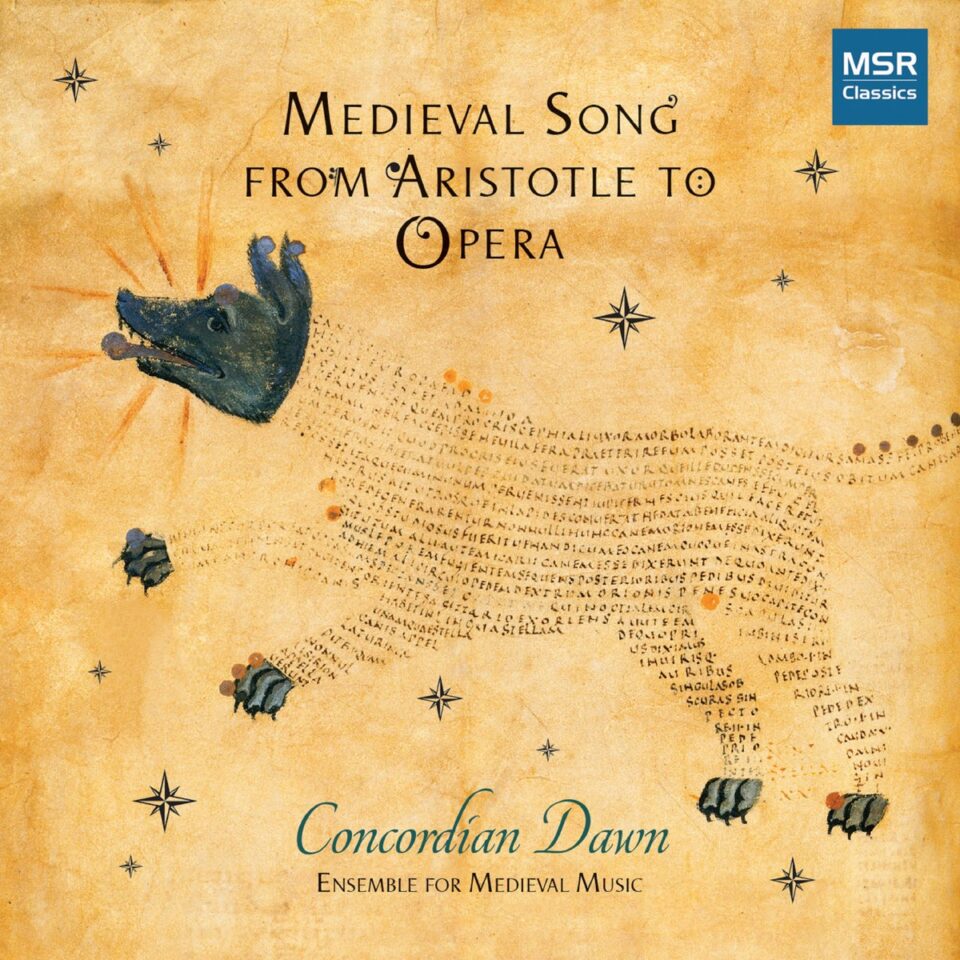Medieval Song from Aristotle to Opera
Medieval Song from Aristotle to Opera is the title of an interdisciplinary publication and recording project by Sarah Kay and Concordian Dawn that focuses on medieval French and Occitan troubadour and trouvère song, inset lyrics in narratives such as those of Guillaume de Machaut, and selected polyphonic songs and motets. This album represents a portion of the fruits of this collaboration, bringing some of the musical recordings to a wider audience.
Our collaboration explores what Kay terms “ecologies” of song and the distinctive voices they give rise to. On this CD you can hear the singing of the stars and sun in the dawn sky (“Phoebi claro”); voices that sing with breath inhaled from—or inspired by—celestial beasts, as their spirit filters down to the earth (“Ensement com la panthere”); song provoked by the touch of personified, abstract presences (“Tieus rit au main,” “Joie, plaisance,” and “En amer” from Le Remede de Fortune); singing that emanates from the singer’s immediate natural surroundings and draws connections between voice, air, life or death, and the soul (“Can lo boschatges,” “Entre.l Taur”); the seductive-yet-lethal sound of the Siren, audible in the quasi-muse-like, flute-and-harp playing half-human-half-beast who sings, but whose song is never exactly recorded or notated (“Volez vous,” “Joie, plaisance,” In virtute/Decens/Clamor); and the sound of internalized song that is as much (if not more) imagined and desired as it is heard (“Nés qu’on porroit”).
Kay describes this method of approaching these songs as “operatic reading” because she wants to emphasize the multimedia, multisensory nature of their performance and manuscript transmission. She does not use “operatic” to mean a performance style and the term has no qualitative bearing on vocal timbre or production. Instead, it aims to integrate the songs to specific audio-visual (and even tactile) environments.
For more information about the book and its companion website, consult Medieval Song from Aristotle to Opera in hard-cover or e-book from Cornell University Press and explore the companion website at:
www.cornellpress.manifoldapp.org/projects/medieval-song
The website contains audio and video recordings of over three hours of songs performed by the members of Concordian Dawn, new editions of each song that I transcribed or reconstructed from manuscript sources, and new translations of the songs by Sarah Kay. Also included are performance reflection essays I wrote to situate the recordings and musical scores in dialogue with each chapter of Kay’s book.
Imagining the sound of medieval song involves a continual negotiation with loss and discovery, about which I wrote as follows (with minor edits and redactions) in my concluding essay on the website:
The original sound of medieval song, as we know, is forever lost to us. Even if we knew exactly how it would have sounded those many centuries ago, our historical distance prohibits us from receiving/perceiving it in the same way that one would have then, and it will never enter our consciousness and “inspire” us as it would have a medieval listener. Yet, reimagining its sound world in an effort to discover what medieval song might have sounded like does inspire us in its own right, little by little bringing us closer to an adequate realization of our own place in time. As Kay observes, “unconfined to its time, de-realized, displaced, and remade in imagination, medieval song will continue being recreated and heard where it is not” (page 248). Our reinterpretation of these songs participates in this process of discovery and loss in an effort to imagine how the songs might have sounded in the Middle Ages, knowing all the while we will never recapture the medieval soundscape. The whole process is a thought project that begins with the anticipation of losing while hoping to find glimpses of medieval soundbites—a process that imitates the whole anachronic journey of this album, book, and website.
Finding historically well-informed approaches to medieval song reconstruction while allowing a song and its context to animate our own imaginations might, at times, lead to historically plausible performance (or moments of performance), but will undoubtedly at other times “‘lose’ its historical specificity beyond recognition, [while also retrieving] for it a relevance to both present and future” (page 238). The cyclical process is fundamental to opening up possibilities and (re)discovering the imaginal riches of the repertoire. An active participation in the imaginative, recreative process is an undeniably valuable and integral part of the performance practice, itself. My intention in all of the music-making endeavors herein was not specifically to create an authentic reconstruction of a medieval song, although the possibility of historically plausible moments was never rejected, but on the contrary hoped for, glimpse by glimpse. Collaborating with Sarah Kay to discover what sounding potential these songs might have in the hopes of offering unforeseen potential and new possibilities, rather, is the heart and soul of our objective, not to mention a personal honor and joy. And, the collection of work offered here is done in the hope of continual inspiration and reanimation into the future.
[Christopher Preston Thompson]
Concordian Dawn, ensemble for medieval music, specializes in 12th- through 14th-century vocal repertoire, drawing on primary source material and focusing on socio-philosophical similarities between texts from centuries ago and the mindset of modern society. In doing so, the ensemble produces a musical experience accessible to contemporary audiences, relating the human condition of the past to the familiar experiences of the present. Concordian Dawn was founded in 2012 and performs regularly on the east coast, annually with Gotham Early Music Scene in NYC, and at venues across the country. The ensemble’s debut album, Fortuna Antiqua et Ultra (MSR Classics, MS1805), was released in December of 2021 to critical acclaim. In July of 2022, Cornell University Press published a collaborative book-recording project between the ensemble and medieval studies scholar, Sarah Kay, entitled Medieval Song from Aristotle to Opera, and this album is a companion release to that collaboration. Concordian Dawn made its west coast debut in 2022 with the Santa Cruz Baroque Festival and at UC-Berkeley and UC-Davis. The ensemble, which received a 2020 Ensemble Forward Award from Chamber Music America, and its director, Christopher Preston Thompson, have performed and led workshops and lectures for Princeton University, Stanford University, the San Francisco Conservatory of Music, New York University, the University of Pennsylvania, Bard College, the Modern Language Association, the CUNY Graduate Center and the Medieval Academy of America, among others.
For more information, please visit www.concordiandawn.com.
Additional musical selections from Medieval Song from Aristotle to Opera are available online for streaming and download.
PROGRAM
Anonymous (11th century) | I-Vb Vat. Lat. 1462, fol. 50v
(melody reconstructed by Christopher Preston Thompson)
Phebi claro nondum orto iubare (Alba of Fleury-sur-Loire)
Philippe de Vitry (1291-1361) | F-Pn NAL 2444, 48r
In virtute nominum / Decens carmen edere / Clamor meus
Guillaume de Machaut (1300-1377) | Machaut MS C, F-Pn fr. 1586, 39r
Joie, plaisance, et douce nourriture (Chant royale from Le Remede de Fortune)
Anonymous (troubadour, 13th century) | F-Pn fonds fr. 844, 199v
Ensement com la panthere
Anonymous (trouvère, 13th century) | F-Pa fonds fr. 5198, 314
Volez vous que je vous chant?
Guillaume de Machaut | Machaut MS E, F-Pn fr. 9221, 178r-v
Nés qu’on porroit (Ballade from Le Livre du Voir dit)
Guillaume de Machaut | Machaut MS C, F-Pn fr. 1586, 30r
Tieus rit au main qui au soire pleure (Complainte from Le Remede de Fortune)
Bernart de Ventadorn (troubadour, fl. 1147-1180) | PC 70.40 (text); I-Ma R71 sup., 19r (melody)
Can lo boschatges es floritz” (melody borrowed from Bernart’s “En consirer et en esmai”)
Raimon Vidal (troubadour, 1196-1252) | Arnaut Daniel (troubadour, fl. 1180-1200)
Bertran de Born (troubadour, fl. 1175-1200) | Monge de Montaudan (troubadour, 1193-1210) (text attributed variously to Vidal and Daniel, PC 411.3; melody from Bertran’s “Rassa tan creis”) (F-Pn fonds fr. 22543, 6v) via the Monge’s “Mot m’enveya” (F-Pn fonds fr. 22543, 40r)
Entre.l Taur e.l Doble Signe
Guillaume de Machaut | Machaut MS C, F-Pn fr. 1586, 46r
En amer a douce vie (balladelle from Le Remede de Fortune)
CLICK TO READ MORE ABOUT THE PROJECT AT CORNELL UNIVERSITY PRESS
MSR Classics


